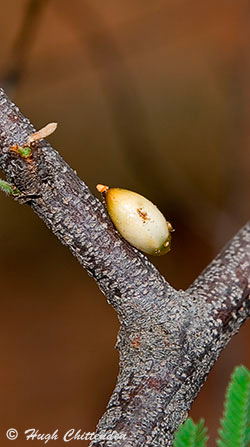Topic : Land Birds
Article 15 ![]() 02 January 2007
02 January 2007
Tinkerbirds – mistletoe dispersers
Tinkerbirds are well known as the primary dispersers of mistletoe plants that parasitize many of our indigenous trees. The photographs in this article not only illustrate just how sticky the flesh of these fruits are, but how important these this food source is to these unobtrusive little ‘tinking’ members of the barbet family.

Yellow-fronted Tinkerbird feeding a nestling with mistletoe fruit
There are 9 species of tinkerbirds, all restricted to the continent of Africa and all belong in the genus Pogoniulus. Although 4 species are officially represented on southern African bird lists, one, Green Tinkerbird Pogoniulus simplex is now considered to be locally extinct. This leaves the three other species, plus Acacia Pied Barbet Tricholaema leucomelas as the primary dispersers of mistletoe plants in southern Africa.

Tinkerbird chicks regurgitate the seeds of mistletoe fruit at the entrance to the nest hole, many of which stick to, or as in this case, are suspended below the nest cavity
Adult Yellow-fronted tinkerbird removing regurgitated mistletoe seeds from the nest entrance
Mistletoes
In southern Africa Mistletoes are parasitic plants made up primarily of the families Loranthaceae and Viscaceae. They are represented in the region by 13 Genera with 38 species, most of which are important food sources for tinkerbirds, Acacia Pied Barbets and other frugivores that feed extensively on the sticky fruit. Their flowers too are important suppliers of nectar for sunbird and white-eye species.



Prior to fledging, tinkerbird chicks swallow the mistletoe fruit whole and regurgitate the seeds after a few minutes. The extremely sticky seeds are discarded from the nest entrance hole with difficulty, often left suspended for a while before they are removed by the adults


Plicosepalus kalachariensis and Viscum rotundifolium fruit
The attached photographs of Yellow-fronted Tinkerbird Pogoniulus chrysoconus were all taken in southern Limpopo Province, near Nylsvlei. Mistletoe species represented in this bushveld region include Plicosepalus kalachariensis, P. amplexicaulis, Erianthemum dregei, Tapinanthus quequensis, T. rubromarginatus, Tieghemia bolusii, Agelanthus natalitius subsp. zeyheri, A. gracilis, Viscum rotundifolium, V. verrucosum, V. obscurum and Oncocalyx bolusii.


The sticky seed of Plicosepalus kalachariensis (left) ready to germinate, and (right), a germinating Erianthemum dregei seed
When the sticky mistletoe seeds are regurgitated, they sometimes drop and stick to the lower branches of the tree, or they may end up stuck to a branch when the birds wipe their bills in an effort to free themselves of this sticky seed.

